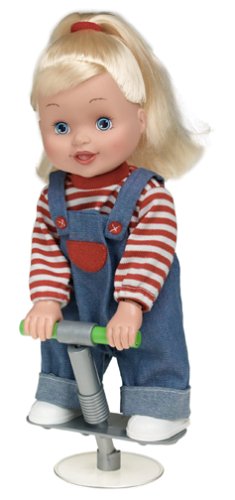Hop Along Katie
Doll that hops on her pogo stick and talks.
 Active doll that comes with a stick horse and pogo stick. Watch her ride her stick horse or hop around on her pogo stick while having fun and saying 10 random phrases.
Active doll that comes with a stick horse and pogo stick. Watch her ride her stick horse or hop around on her pogo stick while having fun and saying 10 random phrases.
The pogo stick, a simple yet exhilarating toy, has a history dating back to the late 19th century. The original concept of bouncing on a spring-loaded device can be traced to George Hansburg's patent for a "spring-stilt" in 1891. However, it was George B. Hansburg Jr. who patented the first recognizable pogo stick design in 1919. This early version consisted of a wooden frame with a spring mechanism and footrests. The term "pogo stick" is believed to have originated from the German word "pochen," meaning "to poke" or "to bounce." The pogo stick gained popularity as a novelty item during the 1920s and 1930s, with people using it for entertainment and in circus acts. In the 1950s, pogo sticks experienced a resurgence in popularity, becoming a fad among children and teenagers. Innovations in materials and engineering improved the performance and durability of pogo sticks, allowing for higher jumps and more stunts. Throughout the years, pogo stick design continued to evolve, incorporating modern materials like lightweight metals and improved spring mechanisms. In the 1980s and 1990s, extreme pogo sticking gained traction as a sport, with enthusiasts performing tricks, flips, and other acrobatics on specially designed pogo sticks. Today, pogo sticks remain a classic outdoor activity and toy, loved by children and adults alike. They offer not only a fun way to bounce and jump but also provide a means of physical exercise and coordination. The pogo stick's enduring appeal demonstrates how a simple concept can continue to captivate generations through its combination of play and physical challenge.
